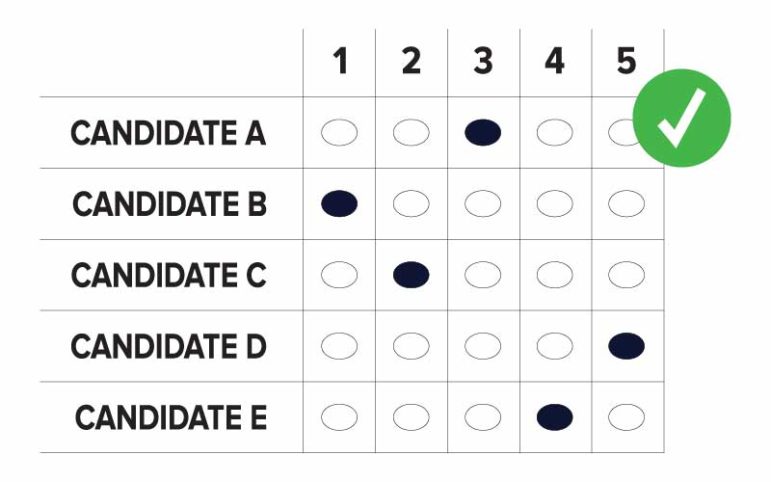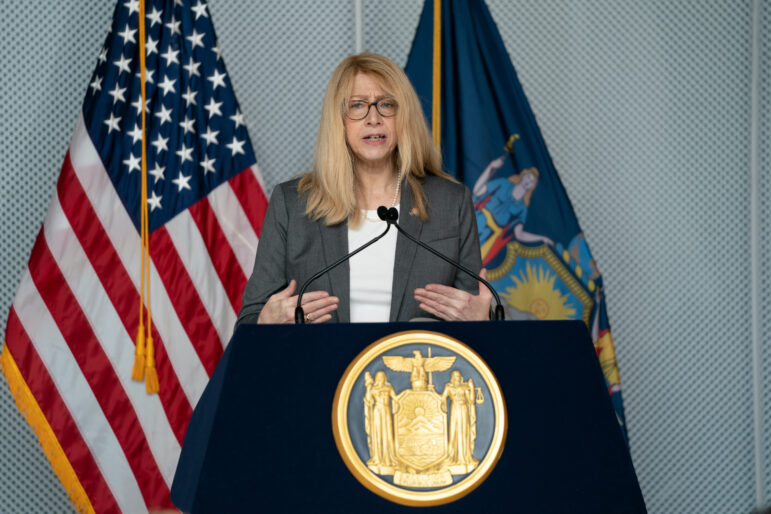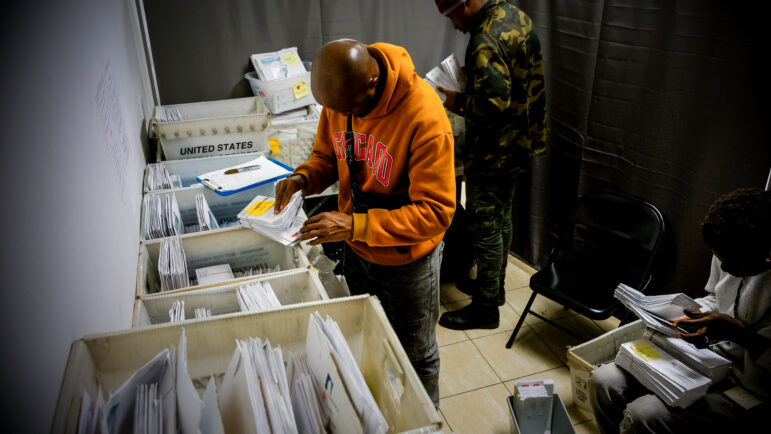Observers say voters are more likely to rank their own votes and better understand the new system if they get encouragement from the system’s power players, like politicians, news outlets, labor unions and advocacy organizations—in the form of endorsements.

NYC Campaign Finance Board
A sample RCV ballot.When it comes to elections, New York City has finally changed the rules of the game. Now the question is how many people are ready to play along.
The new system, Ranked Choice Voting (RCV), gives voters the chance to pick more than one candidate in citywide and local races, potentially enabling someone to win without gaining the most first place votes.
In other cities, RCV has improved turnout, says Jason Salmon, regional director for Citizens Action of New York. “People are more satisfied with their voting since if their first choice doesn’t win they often get someone else they voted for.”
The search for much-needed second and third place votes pushes consensus building and more extensive campaigning, adds Luke Hayes, campaign manager for Rank the Vote, a group formed to help push for this change. “You’ve had council races where a candidate wins a primary with 30percent of the vote because they know they can win big in one section of the district and don’t campaign anywhere else,” Hayes added. “Now they have to engage with more voters.”
This gives outsider candidates a clearer path to victory, which Afua Atta-Mensah, executive director of Community Voices Heard (CVH), says will boost women and people of color, who are chronically underrepresented in the halls of power.
But all those benefits will only accrue if people actually rank their votes. And with a primary election being held two months earlier than usual, in the aftermath of a failed insurrection, seismic presidential transition and in the shadow of both a historic murder trial and local sexual harrassment scandals, observers say voters are more likely to do that if they get encouragement from the system’s power players, like politicians, news outlets, labor unions and advocacy organizations—in the form of endorsements.
The results so far have been mixed. Politicians and organizations have issued a mix of single and ranked choice endorsements in citywide and local races but unions have largely stuck to single endorsements. (The New York Times and Daily News, which typically endorse candidates in municipal elections, would not discuss their plans for the primary.)
“We know it’ll take a little while to catch on and the first run is always confusing,” says Rachel McCullough, political director of Jews for Racial and Economic Justice (JFREJ), which endorses under The Jewish Vote banner.
Hayes, whose group has been training voters, organizations and candidates on RCV, is encouraged by the number of ranked endorsements. Many groups, however, have endorsed only two and occasionally three candidates, even though voters are allowed to rank up to five.
In January, Bronx State Sen. Gustavo Rivera became the first to issue a ranked endorsement in the mayoral race and the City Council race for Bronx district 14, as well as for candidates in two Bronx special elections, jumping in feet first to educate voters.
“I felt New Yorkers needed to be aware of the new system of voting,” he says. He only endorsed two candidates per race, in part because he wanted to support only those he felt strongly about but also because, “I wanted to make sure I did not overextend myself.” (Rivera, like many others, has since rescinded his endorsement of Scott Stringer in the wake of the harassment allegations recently leveled against the comptroller and mayoral hopeful; that leaves just Dianne Morales with Rivera’s support, and the senator has not commented on whether he’d add a new second choice for mayor.)
Advocacy groups based their endorsements on membership interest, and Atta-Mensah says CVH —which issued endorsements for mayor as well as for several Council races—explained the new rules in Zoom forums in English, Spanish and Haitian-Creole. (Among the many groups using ranked endorsements are the Stonewall Democratic Club of New York, the New York Political Action Network, the Freelancers Union, and the Sunrise Movement’s New York chapter.)
Salmon says their organization initially released a slate of single choices but then re-evaluated. “We had an internal discussion and said we really need to lead by example and do ranked choice for some races.”
Kumar Rao, senior director of policy for the New York Working Families Party, said they supported the progressive values of the candidates they chose, including three in the mayor’s race, but they also ranked multiple candidates “to normalize for voters what their ballots could look like.” (They too dropped Stringer, keeping just Morales and Maya Wiley.)
Sean Dugar, Rank the Vote’s education campaign program director, says campaigns in other cities with RCV have become more strategic with each election in sorting how many candidates to rank, what order to put them in and at what point in the campaign to announce their support.
Endorsing groups can list their preferred candidate first even if he or she is a long shot, without worrying about the spoiler effect—they can add a more viable but slightly less desirable candidate second, knowing if their dream candidate falls short, they still have a candidate on their ballot.
McCullough says The Jewish Vote endorsed Morales first for mayor and then Wiley and Stringer as joint number twos (again, before dropping Stringer). The group felt differentiating between second and third place when the enthusiasm at the time was virtually equal was unfair and would suggest a “clear preference” when there wasn’t one. She added that they wanted all the candidates to tout their endorsements and that whomever was ranked third was unlikely to do so. “Those are things we grappled with internally.”
But Dugar says offering second place ties can backfire. “Two second choices can be a little confusing for voters and make them feel like they have to choose only one of the two as their second. They probably won’t think about putting the other person as their third.”
As for timing, Hayes says some groups might want to endorse their favorite candidate six months out, then add second and third choices later on as the race shapes up. Andrea Vasquez, first vice-president for the Professional Staff Congress union at CUNY, says they are returning to some Council races and considering adding in ranked choices behind their initial picks. “It’s more work and a question of capacity but it is good in some ways to see what the field looks like now.”
But Salmon says that for advocacy groups, especially those looking to use ranked endorsements to bestow legitimacy on outsiders, the earlier they endorse, the better. Brandon West, who is running for City Council in the 39th district, agrees. “If you don’t endorse until we’re eight weeks out it’s not super helpful for building credibility—everything is mapped out by then and you have less time to do anything with the endorsement.”
Rao says that while every candidate wants to be number one, they need to be strategic, especially in crowded races where no one is likely to gain 50 percent of the vote during the first round, as RCV requires for a candidate to win; as a result, candidates are mostly embracing being ranked second or third.
“We asked every candidate about their path to victory and their ranked choice strategy,” McCullough says. “Ignoring ranked choice voting is a losing strategy and we were very clear about that to every candidate who met with us.”
Atta Mensah said some candidates sought out being considered for second and were “honored” to get even that level of endorsement.
“We’re still getting support from the organizations or their membership so that’s valuable,” says West, who was endorsed as a second choice in his race by JFREJ and Citizen Action.
Alison Hirsh, a senior advisor to Wiley, says everything depends on the timing and which organization is doing the endorsing. “We’re all for the unity ticket of groups like the Working Family Party and The Jewish Vote—we want to work with them and want Maya’s face on every piece of their literature.”
Sometimes the lines do get blurred.West’s campaign explicitly noted in social media and emails when he was a second choice, but his website lists The Jewish Vote and Citizen Action as endorsers, even though both put rival candidate Shahana Hanif first. Neither group was particularly concerned when they learned of this. “We all just need to figure out how this works,” Salmon says.
Most unions have not bothered with ranking endorsements. (Several, including DC 37 and the United Federation of Teachers, would not provide anyone for interviews.) Even Vasquez says that PSC had “serious and interesting disagreements about what to do in our legislative committee discussion.”
A 32BJ spokesperson said via email that while the union is striving to help their members understand the new voting system, they would not endorse multiple candidates. “Spreading out resources over multiple candidates would dilute our ability to have meaningful influence in each race. We can talk about future elections as they come.”
In an email, Dianne Morales argued that this is the wrong approach, saying that instead of embracing how RCV endorsements can help women and people of color, “some organizations and their leadership are still stuck on the historic and systemic idea of what is viable and what is worth prioritizing.”
And Dugar disputes the efficiency argument, saying organizations “usually have to spend a lot more money to get their single candidate elected” and could strengthen ties with multiple possible elected officials by ranking endorsements.
Observers believe the unions will come around as RCV becomes the new normal. “The culture hasn’t shifted yet,” Rao says. “We’ll see it come to maturity over the next few cycles.”
And the process will evolve for candidates and for the organizations that are already experimenting with the new system. “This year we’re doing the best we can,” McCullough says, “but I think there will be a lot of lessons learned and a lot to analyze after it is over.”
Several people said RCV should reduce negative campaigning. Salmon and McCullough say that after earning ranked endorsements, some candidates are even forming alliances (both emphasize that it’s largely women who are more willing to cooperate). Yet negative comparisons are still a way to stand out. Morales, who has mostly been endorsed alongside Wiley and Stringer, said in an email interview, “Receiving a ranked-choice endorsement is a testament to the strength and momentum our people-powered movement has gathered, especially since candidates endorsed alongside me are financed by real estate developers and super-PACs.”










One thought on “How Ranked Choice Voting is Changing the Endorsement Game in NYC Elections”
It seems like elections are becoming more competitive and candidates need to improve their tactics and votes.